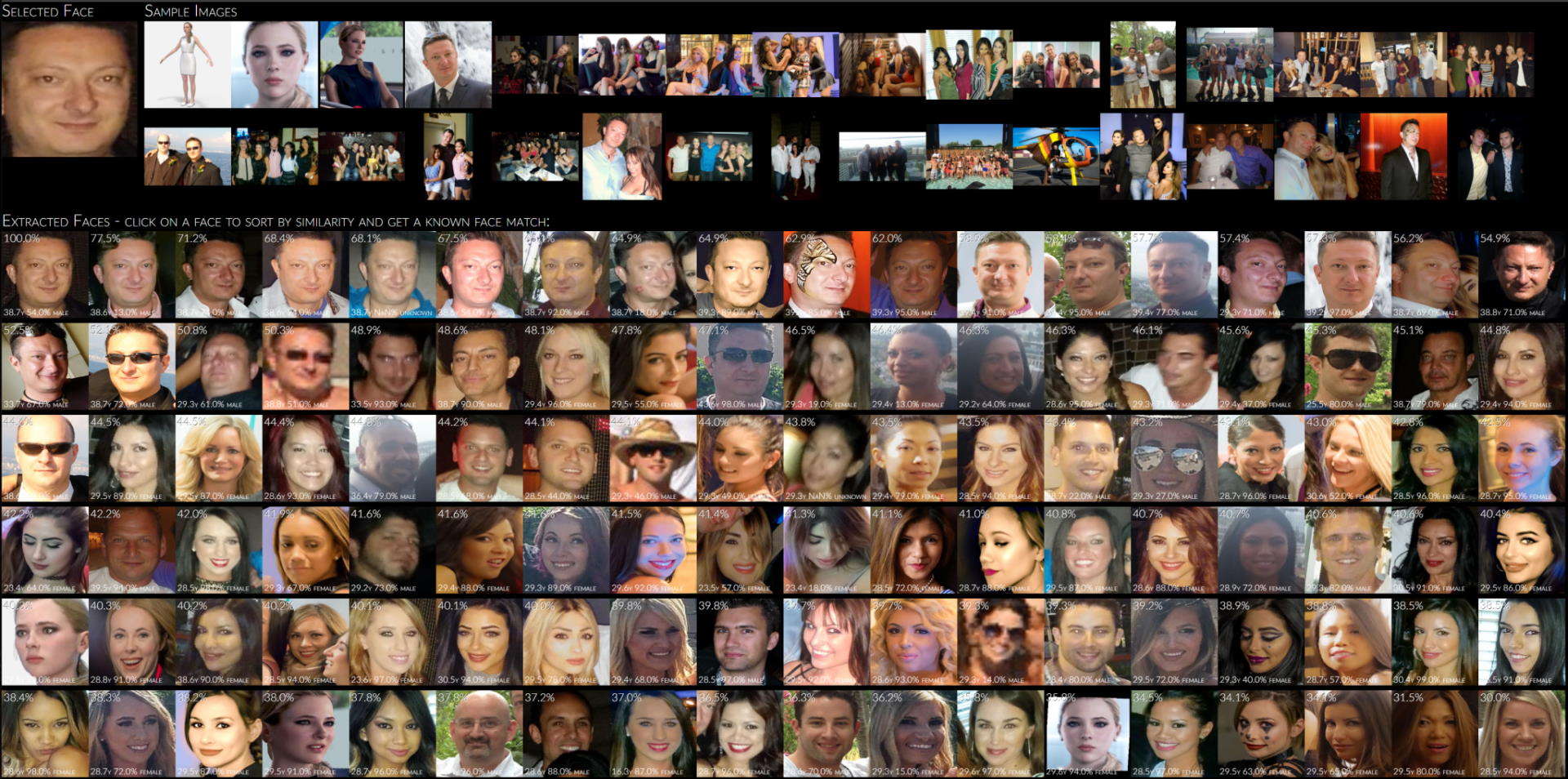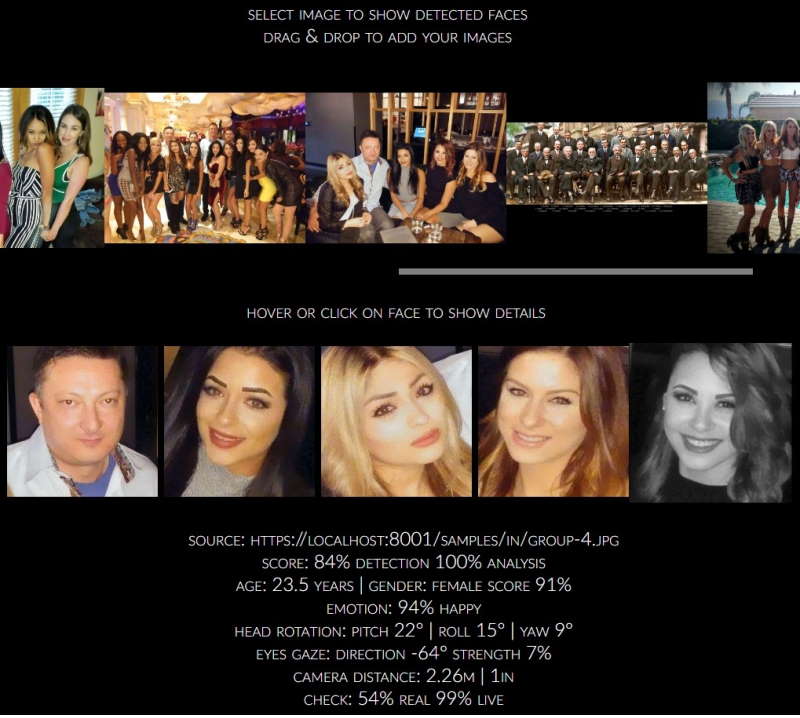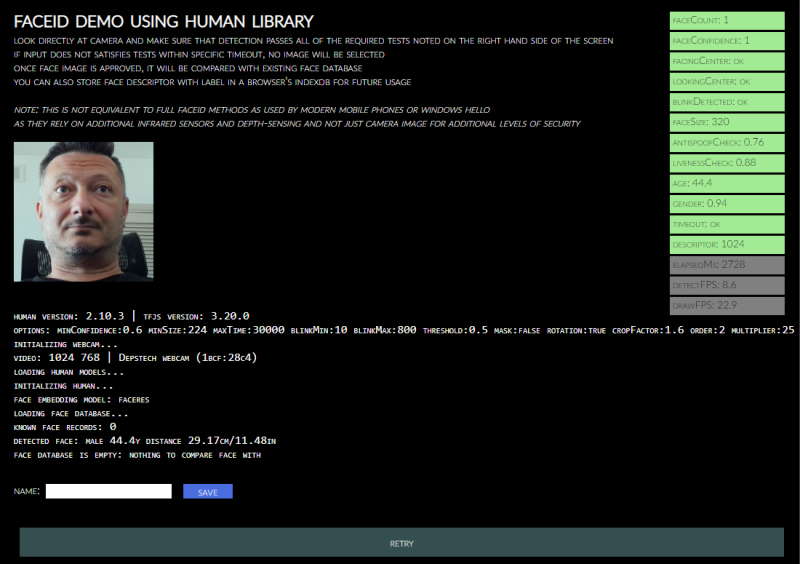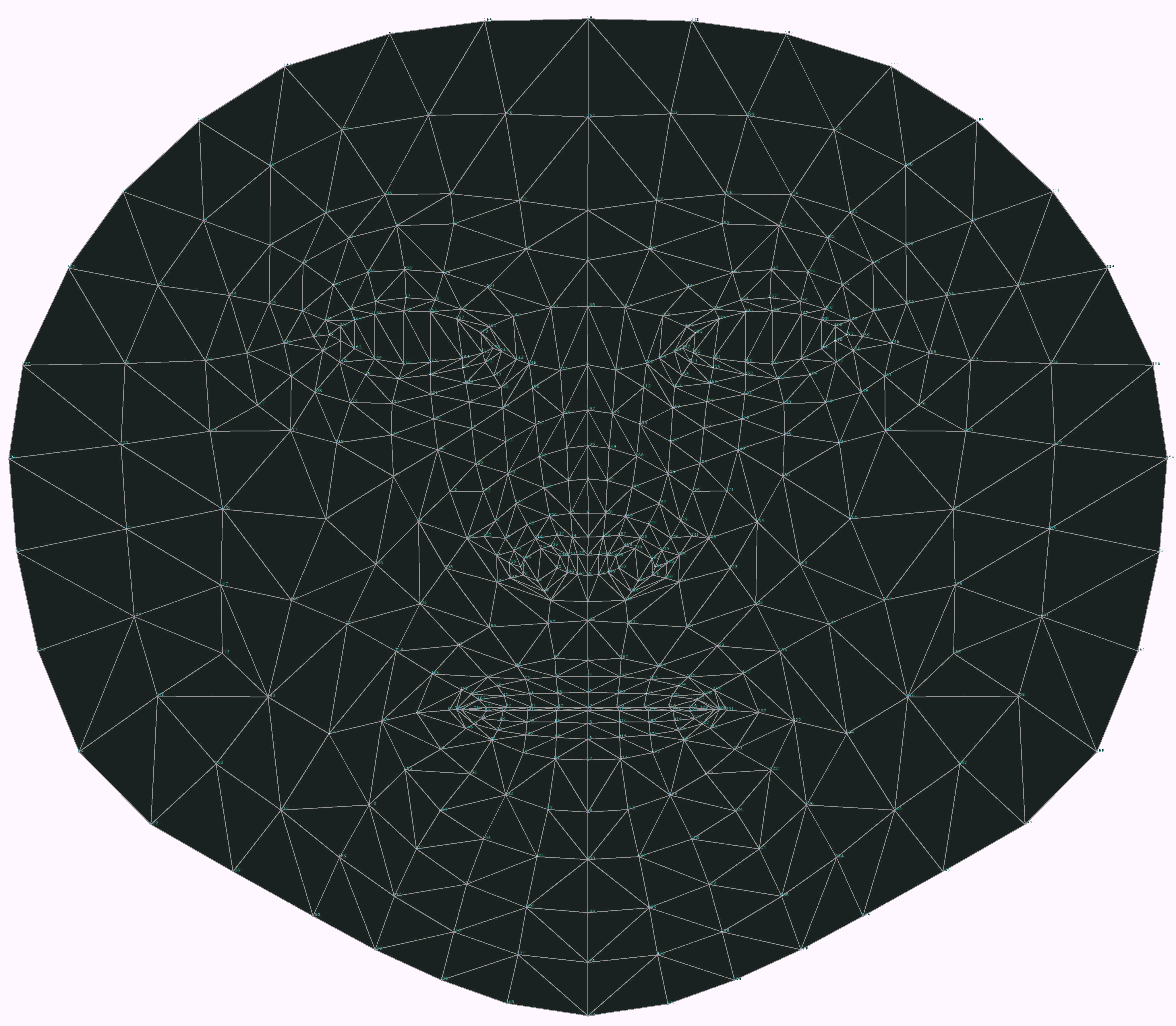human
Human Library
AI-powered 3D Face Detection & Rotation Tracking, Face Description & Recognition,
Body Pose Tracking, 3D Hand & Finger Tracking, Iris Analysis,
Age & Gender & Emotion Prediction, Gaze Tracking, Gesture Recognition, Body Segmentation
Highlights
- Compatible with most server-side and client-side environments and frameworks
- Combines multiple machine learning models which can be switched on-demand depending on the use-case
- Related models are executed in an attention pipeline to provide details when needed
- Optimized input pre-processing that can enhance image quality of any type of inputs
- Detection of frame changes to trigger only required models for improved performance
- Intelligent temporal interpolation to provide smooth results regardless of processing performance
- Simple unified API
- Built-in Image, Video and WebCam handling
Compatibility
- Browser:
Compatible with both desktop and mobile platforms
Compatible with CPU, WebGL, WASM backends
Compatible with WebWorker execution
Compatible with WebView - NodeJS:
Compatibile with WASM backend for executions on architectures where tensorflow binaries are not available
Compatible with tfjs-node using software execution via tensorflow shared libraries
Compatible with tfjs-node using GPU-accelerated execution via tensorflow shared libraries and nVidia CUDA
Releases
- Release Notes
- NPM Link
Demos
Check out Simple Live Demo fully annotated app as a good start starting point (html)(code)
Check out Main Live Demo app for advanced processing of of webcam, video stream or images static images with all possible tunable options
- To start video detection, simply press Play
- To process images, simply drag & drop in your Browser window
- Note: For optimal performance, select only models you’d like to use
- Note: If you have modern GPU, WebGL (default) backend is preferred, otherwise select WASM backend
Browser Demos
All browser demos are self-contained without any external dependencies
- Full [Live] [Details]: Main browser demo app that showcases all Human capabilities
- Simple [Live] [Details]: Simple demo in WebCam processing demo in TypeScript
- Embedded [Live] [Details]: Even simpler demo with tiny code embedded in HTML file
- Face Detect [Live] [Details]: Extract faces from images and processes details
- Face Match [Live] [Details]: Extract faces from images, calculates face descriptors and similarities and matches them to known database
- Face ID [Live] [Details]: Runs multiple checks to validate webcam input before performing face match to faces in IndexDB
- Multi-thread [Live] [Details]: Runs each Human module in a separate web worker for highest possible performance
- NextJS [Live] [Details]: Use Human with TypeScript, NextJS and ReactJS
- ElectronJS [Details]: Use Human with TypeScript and ElectonJS to create standalone cross-platform apps
- 3D Analysis with BabylonJS [Live] [Details]: 3D tracking and visualization of heead, face, eye, body and hand
- VRM Virtual Model Tracking with Three.JS [Live] [Details]: VR model with head, face, eye, body and hand tracking
- VRM Virtual Model Tracking with BabylonJS [Live] [Details]: VR model with head, face, eye, body and hand tracking
NodeJS Demos
NodeJS demos may require extra dependencies which are used to decode inputs
See header of each demo to see its dependencies as they are not automatically installed with Human
- Main [Details]: Process images from files, folders or URLs using native methods
- Canvas [Details]: Process image from file or URL and draw results to a new image file using
node-canvas - Video [Details]: Processing of video input using
ffmpeg - WebCam [Details]: Processing of webcam screenshots using
fswebcam - Events [Details]: Showcases usage of
Humaneventing to get notifications on processing - Similarity [Details]: Compares two input images for similarity of detected faces
- Face Match [Details]: Parallel processing of face match in multiple child worker threads
- Multiple Workers [Details]: Runs multiple parallel
humanby dispaching them to pool of pre-created worker processes - Dynamic Load [Details]: Loads Human dynamically with multiple different desired backends
Project pages
- Code Repository
- NPM Package
- Issues Tracker
- TypeDoc API Specification - Main class
- TypeDoc API Specification - Full
- Change Log
- Current To-do List
Wiki pages
- Home
- Installation
- Usage & Functions
- Configuration Details
- Result Details
- Customizing Draw Methods
- Caching & Smoothing
- Input Processing
- Face Recognition & Face Description
- Gesture Recognition
- Common Issues
- Background and Benchmarks
Additional notes
- Comparing Backends
- Development Server
- Build Process
- Adding Custom Modules
- Performance Notes
- Performance Profiling
- Platform Support
- Diagnostic and Performance trace information
- Dockerize Human applications
- List of Models & Credits
- Models Download Repository
- Security & Privacy Policy
- License & Usage Restrictions
See issues and discussions for list of known limitations and planned enhancements
Suggestions are welcome!
App Examples
Visit Examples gallery for more examples

Options
All options as presented in the demo application…
demo/index.html
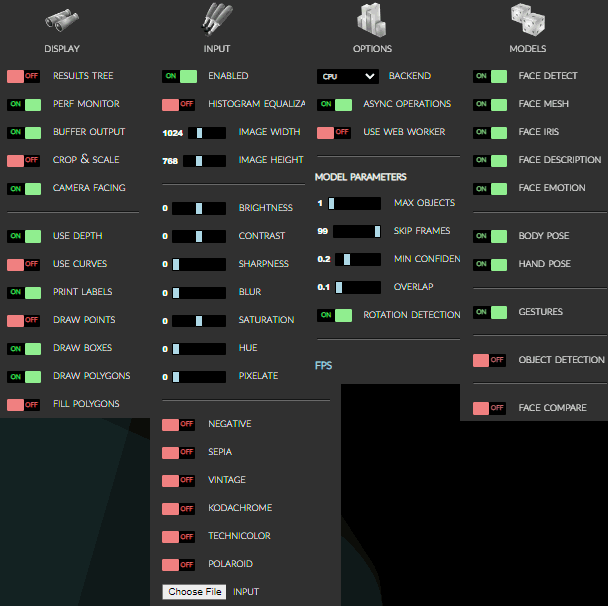
Results Browser:
[ Demo -> Display -> Show Results ]
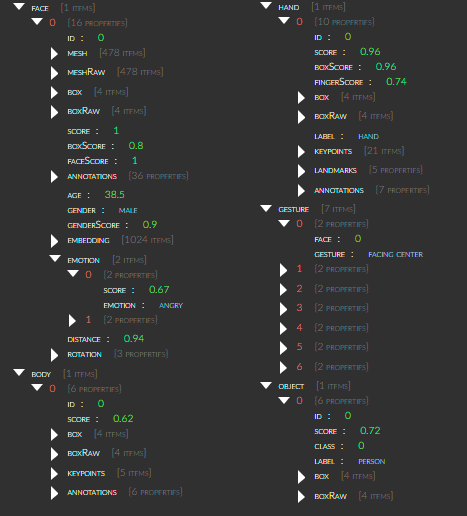
Advanced Examples
- Face Similarity Matching:
Extracts all faces from provided input images,
sorts them by similarity to selected face
and optionally matches detected face with database of known people to guess their names
- Face Detect:
Extracts all detect faces from loaded images on-demand and highlights face details on a selected face
- Face ID:
Performs validation check on a webcam input to detect a real face and matches it to known faces stored in database
- 3D Rendering:
- VR Model Tracking:
- Human as OS native application:
468-Point Face Mesh Defails:
(view in full resolution to see keypoints)
<hr>
Quick Start
Simply load Human (IIFE version) directly from a cloud CDN in your HTML file:
(pick one: jsdelirv, unpkg or cdnjs)
<!DOCTYPE HTML>
<script src="https://cdn.jsdelivr.net/npm/@vladmandic/human/dist/human.js"></script>
<script src="https://unpkg.dev/@vladmandic/human/dist/human.js"></script>
<script src="https://cdnjs.cloudflare.com/ajax/libs/human/3.0.0/human.js"></script>
For details, including how to use Browser ESM version or NodeJS version of Human, see Installation
Code Examples
Simple app that uses Human to process video input and
draw output on screen using internal draw helper functions
// create instance of human with simple configuration using default values
const config = { backend: 'webgl' };
const human = new Human.Human(config);
// select input HTMLVideoElement and output HTMLCanvasElement from page
const inputVideo = document.getElementById('video-id');
const outputCanvas = document.getElementById('canvas-id');
function detectVideo() {
// perform processing using default configuration
human.detect(inputVideo).then((result) => {
// result object will contain detected details
// as well as the processed canvas itself
// so lets first draw processed frame on canvas
human.draw.canvas(result.canvas, outputCanvas);
// then draw results on the same canvas
human.draw.face(outputCanvas, result.face);
human.draw.body(outputCanvas, result.body);
human.draw.hand(outputCanvas, result.hand);
human.draw.gesture(outputCanvas, result.gesture);
// and loop immediate to the next frame
requestAnimationFrame(detectVideo);
return result;
});
}
detectVideo();
or using async/await:
// create instance of human with simple configuration using default values
const config = { backend: 'webgl' };
const human = new Human(config); // create instance of Human
const inputVideo = document.getElementById('video-id');
const outputCanvas = document.getElementById('canvas-id');
async function detectVideo() {
const result = await human.detect(inputVideo); // run detection
human.draw.all(outputCanvas, result); // draw all results
requestAnimationFrame(detectVideo); // run loop
}
detectVideo(); // start loop
or using Events:
// create instance of human with simple configuration using default values
const config = { backend: 'webgl' };
const human = new Human(config); // create instance of Human
const inputVideo = document.getElementById('video-id');
const outputCanvas = document.getElementById('canvas-id');
human.events.addEventListener('detect', () => { // event gets triggered when detect is complete
human.draw.all(outputCanvas, human.result); // draw all results
});
function detectVideo() {
human.detect(inputVideo) // run detection
.then(() => requestAnimationFrame(detectVideo)); // upon detect complete start processing of the next frame
}
detectVideo(); // start loop
or using interpolated results for smooth video processing by separating detection and drawing loops:
const human = new Human(); // create instance of Human
const inputVideo = document.getElementById('video-id');
const outputCanvas = document.getElementById('canvas-id');
let result;
async function detectVideo() {
result = await human.detect(inputVideo); // run detection
requestAnimationFrame(detectVideo); // run detect loop
}
async function drawVideo() {
if (result) { // check if result is available
const interpolated = human.next(result); // get smoothened result using last-known results
human.draw.all(outputCanvas, interpolated); // draw the frame
}
requestAnimationFrame(drawVideo); // run draw loop
}
detectVideo(); // start detection loop
drawVideo(); // start draw loop
or same, but using built-in full video processing instead of running manual frame-by-frame loop:
const human = new Human(); // create instance of Human
const inputVideo = document.getElementById('video-id');
const outputCanvas = document.getElementById('canvas-id');
async function drawResults() {
const interpolated = human.next(); // get smoothened result using last-known results
human.draw.all(outputCanvas, interpolated); // draw the frame
requestAnimationFrame(drawResults); // run draw loop
}
human.video(inputVideo); // start detection loop which continously updates results
drawResults(); // start draw loop
or using built-in webcam helper methods that take care of video handling completely:
const human = new Human(); // create instance of Human
const outputCanvas = document.getElementById('canvas-id');
async function drawResults() {
const interpolated = human.next(); // get smoothened result using last-known results
human.draw.canvas(outputCanvas, human.webcam.element); // draw current webcam frame
human.draw.all(outputCanvas, interpolated); // draw the frame detectgion results
requestAnimationFrame(drawResults); // run draw loop
}
await human.webcam.start({ crop: true });
human.video(human.webcam.element); // start detection loop which continously updates results
drawResults(); // start draw loop
And for even better results, you can run detection in a separate web worker thread
<hr>
Inputs
Human library can process all known input types:
Image,ImageData,ImageBitmap,Canvas,OffscreenCanvas,Tensor,HTMLImageElement,HTMLCanvasElement,HTMLVideoElement,HTMLMediaElement
Additionally, HTMLVideoElement, HTMLMediaElement can be a standard <video> tag that links to:
- WebCam on user’s system
- Any supported video type
e.g..mp4,.avi, etc. - Additional video types supported via HTML5 Media Source Extensions
e.g.: HLS (HTTP Live Streaming) usinghls.jsor DASH (Dynamic Adaptive Streaming over HTTP) usingdash.js - WebRTC media track using built-in support
<hr>
Detailed Usage
- Wiki Home
- List of all available methods, properies and namespaces
- TypeDoc API Specification - Main class
-
TypeDoc API Specification - Full
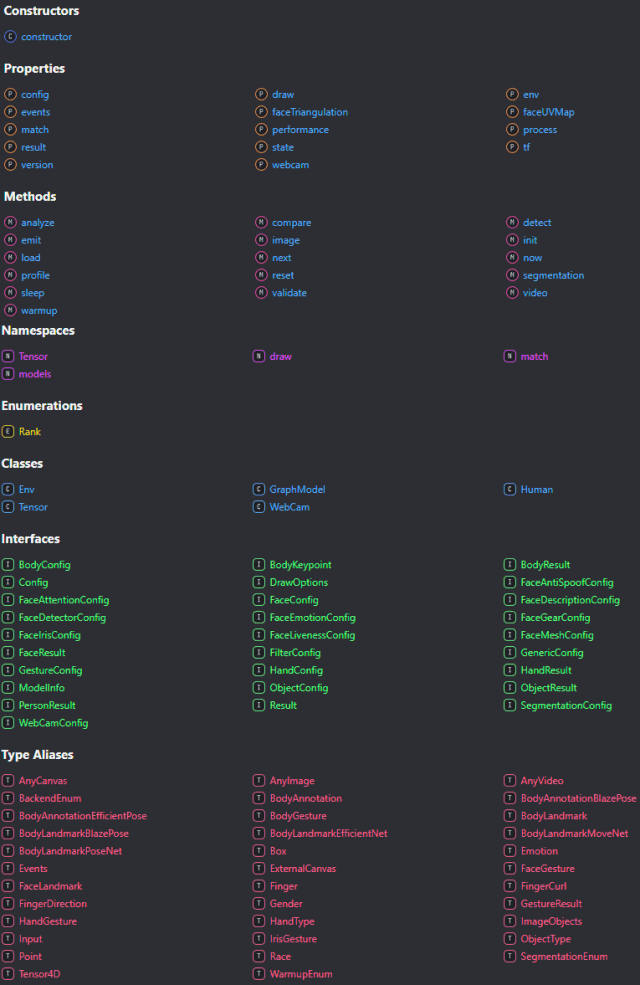
<hr>
TypeDefs
Human is written using TypeScript strong typing and ships with full TypeDefs for all classes defined by the library bundled in types/human.d.ts and enabled by default
Note: This does not include embedded tfjs
If you want to use embedded tfjs inside Human (human.tf namespace) and still full typedefs, add this code:
import type * as tfjs from ‘@vladmandic/human/dist/tfjs.esm’;
const tf = human.tf as typeof tfjs;
This is not enabled by default as Human does not ship with full TFJS TypeDefs due to size considerations
Enabling tfjs TypeDefs as above creates additional project (dev-only as only types are required) dependencies as defined in @vladmandic/human/dist/tfjs.esm.d.ts:
@tensorflow/tfjs-core, @tensorflow/tfjs-converter, @tensorflow/tfjs-backend-wasm, @tensorflow/tfjs-backend-webgl
<hr>
Default models
Default models in Human library are:
- Face Detection: MediaPipe BlazeFace Back variation
- Face Mesh: MediaPipe FaceMesh
- Face Iris Analysis: MediaPipe Iris
- Face Description: HSE FaceRes
- Emotion Detection: Oarriaga Emotion
- Body Analysis: MoveNet Lightning variation
- Hand Analysis: HandTrack & MediaPipe HandLandmarks
- Body Segmentation: Google Selfie
- Object Detection: CenterNet with MobileNet v3
Note that alternative models are provided and can be enabled via configuration
For example, body pose detection by default uses MoveNet Lightning, but can be switched to MultiNet Thunder for higher precision or Multinet MultiPose for multi-person detection or even PoseNet, BlazePose or EfficientPose depending on the use case
For more info, see Configuration Details and List of Models
<hr>
Diagnostics
<hr>
Human library is written in TypeScript 5.1 using TensorFlow/JS 4.10 and conforming to latest JavaScript ECMAScript version 2022 standard
Build target for distributables is JavaScript EMCAScript version 2018
For details see Wiki Pages
and API Specification







